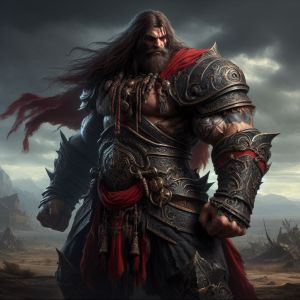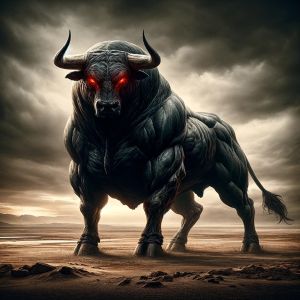Dorgross

Dorgross stands as a beacon of conflict and valor, his essence woven with the very threads of war and chaos. This deity, embodying the raw force of violence, moves with purposeful strides, eschewing the trappings of diplomacy for the clarity of action. His realm is the battlefield, a place where he finds solace regardless of the cause, for it is not the morality of the fight that stirs his spirit, but the fight itself.
Victory is his creed, pursued with a zeal that admits no qualms about the methods employed. The ends, in his view, sanctify the means, rendering each battle a testament to the glory of conquest. Yet, despite his fearsome reputation, Dorgross commands respect across the pantheon. Even those who recoil at his ferocity cannot deny the brilliance of his tactical mind or the unwavering leadership he exhibits amidst the fray.
Curiously, Dorgross's aggression is not without its principles. He despises the exploitation of the weak, viewing such acts as the height of cowardice. True valor, in his eyes, lies in the challenge of the stronger, in the relentless pursuit of self-improvement through combat against formidable foes. This nuanced stance on power and strength reveals a complex deity, one who champions the warrior's path not through domination but through the honor of continuous self-overcoming.
Dorgross manifests as a towering figure, embodying the very essence of war and conflict. His form is that of a muscular man, enshrouded in a set of dark full plate armor that boasts an intricate design, testament to the artistry of war. Sometimes a dark helmet veils his visage, leaving his intentions as enigmatic as the shadows that dance across his armor. Other times his face is visible, with long red hair and beard flowing unkept. Swept back by the winds of battle, a red scarfed cloak flutters behind him, a stark contrast to the darkness of his attire. In his grasp, he wields a brutal barbarian greatsword, its blade whispering tales of battles past and foes vanquished. This image of Dorgross is not just a representation of his dominion over war but also an embodiment of his unyielding spirit and relentless pursuit of victory. Dorgross also shows himself in an alternate form as a formidable, muscled black bull with fiery red eyes, encapsulating his immense strength and fierce spirit.
Symbol
The holy symbol of Dorgross, a medallion crafted from rough iron, features a central greatsword embedded into a pile of shattered weapons. This symbol represents Dorgross's dominion over war, highlighting both his might and the inevitability of victory in conflicts he oversees. The greatsword signifies leadership and strength, while the shattered weapons beneath it symbolize the defeat of his enemies and the end of battles.
Relations With Other Deities

Dorgross stands apart as a deity of savagery who eschews the bindings of morality. His indifference to the moral compass places him at odds with many in the celestial pantheon, where his unyielding nature is often viewed with skepticism. Yet, through the crucible of battle, he has forged a grudging respect for those deities who demonstrate valor and prowess, including Bahamut, the embodiment of goodness, and Aerion, the radiant deity of the sun. Among these celestial beings, Crossus commands a unique reverence from Dorgross, a testament to qualities that transcend their inherent differences.
Within the realm of neutrality, Dorgross finds a kindred spirit in Aios, whose leadership offers the promise of battle and self-test. Chrovonner, despite a rigid adherence to law that Dorgross finds constricting, earns his respect for reasons unspoken.
Even among the shadows of the Dread pantheon, Dorgross's respect is discerning but present. He sees in Xendral, the tyrant of oppression, and Tarnull, the lord of earthquakes and volcanoes, a reflection of his own indomitable spirit and the raw, unbridled force of nature that he embodies.
What The Legends Say
This is in a state of significant expansion or restructuring We hope we can have this content ready soon. |
Dogma

Dorgross dogma consists of these five principles:
- Embrace Conflict: Life's essence is trial through battle. Followers of Dorgross see every challenge as a crucible for growth, seeking conflicts that forge their spirit and physique. This tenet advocates for conflict not as an end to destruction but as a means to unearth one's true potential and resilience.
- Victory at Any Cost: The glory of victory justifies the means, sanctioning the use of any tactics necessary—be it cunning, strategy, or brute force. It underscores the belief that triumph vindicates the methods employed, encouraging followers to adapt and overcome no matter what.
- Might Defines Right: he victor's narrative is the truth. This tenet places the outcome of battles as the ultimate arbiter of justice and truth, promoting the idea that strength and victory are not merely tools but the very foundations of righteousness.
- Despise Cowardice: This commandment condemns the misuse of power against those weak and unworthy. It instills a culture where true warriors seek out equals or greater challenges, emphasizing the importance of honor in strength and the pursuit of challenges that push one to the brink, fostering growth and prowess.
- Decisiveness in Action: Advocating for immediacy and resolution, this tenet positions hesitation as the antithesis of achievement. Followers are encouraged to act swiftly and decisively, embodying the belief that true glory and victory are borne from the courage to act promptly and with conviction.
Clergy and Temples

The clergy of Dorgross, a bastion of martial prowess and divine fervor, is a unique amalgamation of clerics and warriors, each a master of warfare in their own right. This cadre is not just a religious institution but a formidable force, deeply versed in the arts of conflict, strategy, and leadership. Their understanding of war transcends mere combat; it is a philosophy, a way of life that guides their actions and decisions, making them unparalleled leaders and tacticians.
Within this sacred order, hierarchy is fluid, sculpted by the crucible of combat rather than the rigid structures of tradition. Leadership is earned through valor and experience on the battlefield, ensuring that those at the helm are warriors of the highest caliber. Yet, this flexible hierarchy belies an ability to swiftly coalesce into a disciplined, military-like structure when the call to arms is sounded, transforming a loosely organized order into a tight-knit legion ready for war.
Their relentless pursuit of martial excellence is not merely a duty but a calling, and the clergy of Dorgross, when acting as a whole, becomes a formidable army on its own that can change the tides of battles. In quieter times, when not bound by collective endeavors of war, these devout warriors follow personal quests for improvement, aligning with causes that promise the growth of their martial skills. Many dedicate themselves to serving in the armies of their home regions, fully immersing in the art of war unless the church beckons. Others embrace the role of mercenaries, seeking a patron that can give them a cause that promise the growth of their martial skills. This freedom, encouraged by the clergy, sees them navigating the complexities conflict, sometimes even taking arms for opposing factions, a testament to their individual paths to prowess under Dorgross's tenets.
Such practices underscore the clergy's complex relationship with the world's geopolitical landscape, with members seamlessly integrating into the martial fabric of their homelands while maintaining allegiance to their divine patron. This duality ensures that the clergy's influence permeates far beyond the confines of their temples, making them a formidable presence in any conflict, driven by the unyielding spirit of Dorgross.
The temples of Dorgross, reflecting the deity's martial and strategic essence, are strategically placed both within bustling population centers and in isolated, tactically significant locations. Urban temples serve dual purposes as recruitment hubs for the clergy and as centers where warriors and patrons alike seek the clergy's services for intelligence, provisions, and equipment. In contrast, the secluded temples stand as fortified strongholds, guarding critical passes and bridges, ready to transform into bastions during sieges.
These sacred sites are also centers of martial education, offering training in the arts of war to both clergy recruits and visiting warriors during peacetime. Furthermore, they house extensive workshops for the construction of siege engines and other war devices, underscoring the temples' role in preparing for and engaging in warfare. This dual nature of Dorgross's temples—as places of worship, training, and preparation for conflict—highlights the deity's dominion over war and strategy.
Initiation
Under the vigilant gaze of Dorgross's temples, the journey to initiation begins with a solemn pledge made a year before the initiation ritual, normally a year before the aspirant's coming of age. Approaching the temple's threshold, the initiate seeks acceptance into the deity's fold, marking the start of a year dedicated to rigorous martial discipline. They delve into the mastery of both armed and unarmed combat, their bodies and spirits honed through the crucible of controlled war games and, when fate allows, the harsher lessons of actual combat.
This period of physical and spiritual preparation is punctuated daily by at least an hour of meditation, a quiet reflection on the day's trials and triumphs, forging a deeper connection to Dorgross's dogma. As the year wanes, a final day of isolation beckons, dedicated to introspection on the teachings of Dorgross and the initiate's readiness to embody these principles.
Dawn of the following day brings the initiate before the altar, kneeling in anticipation. A cleric, channeling the deity's presence, bestows upon them a weapon. Upon Delivery of the weapon the cleric casts the initiation spell. This act, laden with prayers to Dorgross, symbolizes the forge of a sacred bond between deity and devotee. The weapon, a tangible symbol of their commitment, prepares them for the path ahead — be it joining the clergy's ranks, venturing forth as soldiers, or returning to their communities, ever ready to heed the call of Dorgross. This ceremony is not merely a rite of passage but a covenant, marking them as warriors in reserve, bound to the will of their patron deity.

